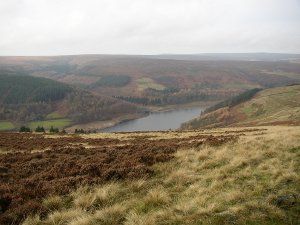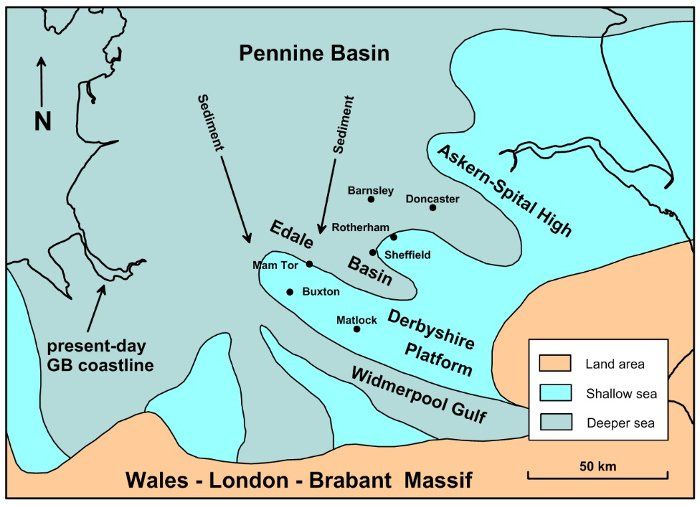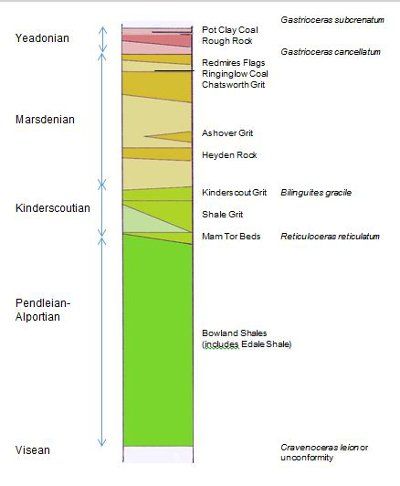NAMURIAN
Recording, conserving and promoting the landscape and rocks of the Sheffield region
Namurian Stage
Namurian is the Stage name for rocks of Carboniferous age, which were formerly referred to as the Millstone Grit Series. The Namurian rocks range in age from 326 to 315 million years. ago.
Distribution
Rocks of Namurian age crop out along the western side of the Sheffield region and the adjacent Dark Peak area of the Peak District National Park. The Namurian sequence, which is at least 600 m thick, consists of alternating sandstones, gritstones, mudstones and shales, forming the eastern limb of the broad Pennine anticline. Differential erosion of the easterly dipping strata has resulted in a succession of spectacular west-facing escarpments, known locally as "edges" e.g. Stanage Edge, beloved by climbers.

Fig. 1: Ladybower Reservoir, on rocks of Namurian age. Photo: J. Hunter
Namurian rocks throughout the sequence have long featured in the economy of the region, e.g. as building stones, as grinding stones, as raw materials for the cement industry and with the potential for hydrocarbon resources. The deep valleys, floored by impermeable shales, have provided ideal sites for water reservoirs, to supply Sheffield and other cities in the Midlands.
Only the younger Namurian strata crop out in our area, but they are underlain by the full succession, so a brief description of each major unit will be given, whether it is exposed at the surface in our district or in the Peak District to the west of this area (Rocks of Namurian age are shown in green on the geological map of our region) see "South Yorkshire Geology" map).
Tectonic Setting
The Namurian is preceded by prolonged deposition of predominantly carbonate sediments during the Visean, which took place in a number of marine basin and platform structures, lying within the overall Pennine Basin. The upland area known as the Wales-Brabant High lay to the south, and the Caledonian mountains of Scotland/Laurentia/Scandinavia lay further away to the north. This broad pattern continued throughout the Namurian and into the overlying Westphalian.
(See "cartoon" of the global setting for these times under "Westphalian" Figure 1. See Figure 2, below, for the broad regional palaeogeography for much of the Namurian).

Fig. 2: Palaeogeographic map of the southern Pennine Basin during the Namurian.
(J. Hunter, adapted from Smith et al, 2005)
Sedimentation was dominantly of clastic material (i.e. gravel, sand, silt and mud), derived from the upland areas, in contrast to the carbonates of the Visean below. This is thought to be due to renewed uplift of the source areas in the ancient continental area to the north, perhaps accompanied by increased rainfall and run-off from the land, compared to more arid conditions and lower surrounding land in the Visean. Early Namurian deposition consisted mainly of deep water marine muds, which accumulated very slowly, to judge from the numerous bands of evolving goniatites. Later sedimentation reflected the gradual advance of a major river delta from a broadly northerly source, bringing at first distal muds and silts, to be followed by turbidites and coarsening-upwards sequences, culminating in the coarse grits of successive delta tops. Later, successive uplift/subsidence events resulted in the return of deep water conditions and the deposition of shales. As the sedimentation continued and water depth decreased, sands were again deposited in delta systems. Some of these briefly even became land areas, marked by localised erosion and the deposition of thin coal seams.
Stratigraphy

The Namurian rocks of the South Pennines are divided into four regional sub-stages (divisions of time), based on the fossils they contain. From youngest to oldest these are Yeadonian, Marsdenian, Kinderscoutian and Pendleian-Alportian, all named after places in the South Pennines. For field purposes, the traditional division based on the lithology of the rocks is probably more practical. On this basis, the Namurian is divided into two major Groups. The younger is the Millstone Grit Group, which includes the upper three sub-stages and consists of coarse-grained sandstones with angular grains, known as grits, although there are also substantial thicknesses of finer-grained sandstones, siltstones, shales and occasional thin coals.The older of these is the Craven Group, which is dominated by fine-grained sediments, collectively known as the Bowland Shale Formation of Pendleian-Alportian age.
Fig. 3: Generalised stratigraphical column for the Namurian in the East Pennine Basin showing selected horizons. Not to scale (Contains BGS data © Crown copyright and database rights 2012)
References
- British Geological Survey, 2008. Stratigraphical chart of the United Kingdom: Southern Britain.
- Eden, R.A., Stevenson, I.P. and Edwards, W., 1957. Geology of the country around Sheffield. Memoirs of the Geological Survey of Great Britain, One-inch Geological Sheet 100, New Series
- Smith N.J.P., Kirby G.A., Pharaoh T.C. 2005 Structure and Evolution of the south-west Pennine Basin and adjacent areas.
BGS Keyworth / NERC copyright
- Stevenson, I.P. Gaunt, G.D. 1971. Geology of the Country around Chapel-en-le-Frith.
Memoirs of the Geological Survey of Great Britain, One-inch Geological Sheet 99, New Series
- Waters, C.N. Chisholm, J.I. Benfield, A.C. and O'Beirne, A.M., 2008. Regional evolution of a fluviodeltaic cyclic succession in the Marsdenian (Late Namurian Stage, Pennsylvanian) of the Central Pennine Basin, U.K. Proceedings Yorkshire Geological Society, v57, pp1-28
- Waters, C. N. Waters, R. A. Barclay, W. J. and Davies, J. R., 2009. A lithostratigraphical framework for the Carboniferous successions of southern Great Britain (onshore).
British Geological Survey Research Report RR/09/01
- Woodcock N. & Strachan R. (Eds) 2000. Geological history of Britain and Ireland.
Blackwell Publishing. (Pages 240 onwards)
- http://www.bgs.ac.uk/lexicon/home.html
- http://www.mangeolassoc.org.uk/castleshawmoorjuly2008.htm - field trip report with sketches of goniatites and bivalves.
email: sageologytrust@gmail.com
Copyright: Sheffield Area Geology Trust. Registered Charity No. 1133465, England
